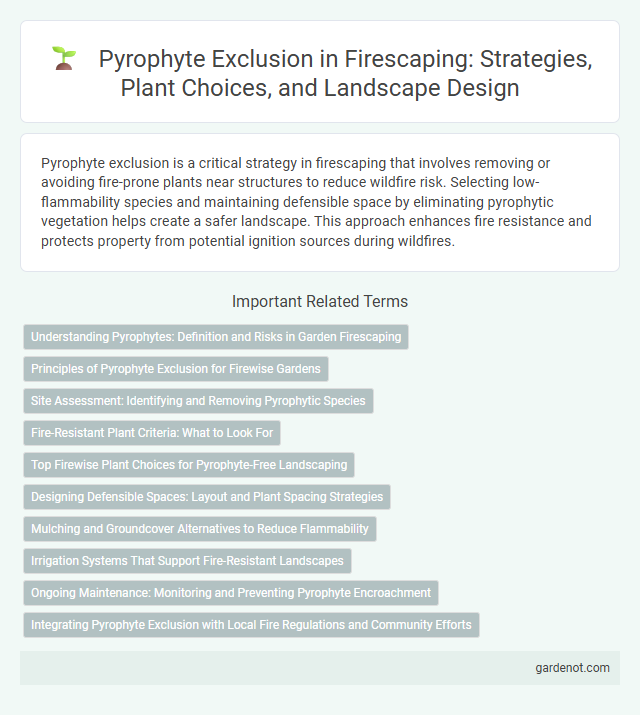Pyrophyte exclusion is a critical strategy in firescaping that involves removing or avoiding fire-prone plants near structures to reduce wildfire risk. Selecting low-flammability species and maintaining defensible space by eliminating pyrophytic vegetation helps create a safer landscape. This approach enhances fire resistance and protects property from potential ignition sources during wildfires.
Understanding Pyrophytes: Definition and Risks in Garden Firescaping
Pyrophytes are plants adapted to withstand or even thrive after fire, often possessing flammable oils and resins that can increase fire risk in garden firescaping. Understanding these species is crucial for effective pyrophyte exclusion, as their presence may promote rapid fire spread and jeopardize property safety. Selecting low-flammability vegetation and implementing strategic plant placement can significantly reduce fire hazards associated with pyrophytes in landscape design.
Principles of Pyrophyte Exclusion for Firewise Gardens
Pyrophyte exclusion in Firewise gardens centers on selecting low-flammability, fire-resistant plants to reduce combustible vegetation near structures. Principles include maintaining proper spacing between plants to prevent fire spread, removing dead or dry foliage regularly, and incorporating hardscape elements like gravel or stone to act as firebreaks. These strategies minimize fuel sources and enhance garden resilience against wildfires.
Site Assessment: Identifying and Removing Pyrophytic Species
Site assessment for firescaping involves accurately identifying pyrophytic species such as chaparral, eucalyptus, and certain pines that are highly flammable and increase wildfire risk. Removing these vegetation types reduces fuel loads and enhances fire-resistant landscaping effectiveness. Detailed mapping and plant inventory support targeted removal and replacement with fire-resistant alternatives.
Fire-Resistant Plant Criteria: What to Look For
Fire-resistant plants display characteristics such as high moisture content in leaves, thick and fleshy foliage, and minimal accumulation of dead material that can ignite easily. These plants often have low resin or oil content, reducing flammability, and possess open, airy branch structures that limit fire spread. Selecting species native to fire-prone regions improves landscape resilience by ensuring adaptability to local fire regimes.
Top Firewise Plant Choices for Pyrophyte-Free Landscaping
Top firewise plant choices for pyrophyte-free landscaping include species with high moisture content and low oil or resin levels, such as succulents like aloe vera and agave, and deciduous trees like maples and oaks. These plants reduce fire risk by limiting combustible material and retaining water, creating defensible spaces around properties. Incorporating native fire-resistant plants like manzanita and creosote bush enhances landscape resilience against wildfires.
Designing Defensible Spaces: Layout and Plant Spacing Strategies
Designing defensible spaces in firescaping involves strategically spacing pyrophyte plants to reduce fire risk and impede flame spread. Maintaining adequate separation between vegetation clusters and incorporating non-combustible materials ensures safe zones that slow fire progression. Proper layout prioritizes fire-resistant species placement and clear access for firefighting efforts, enhancing overall property protection.
Mulching and Groundcover Alternatives to Reduce Flammability
Mulching with non-woody, moist materials like compost or gravel effectively reduces fire hazards by maintaining soil moisture and minimizing ignition sources. Selecting low-flammability groundcovers such as native succulents, creeping sedums, or drought-tolerant herbaceous plants creates natural firebreaks while enhancing landscape aesthetics. These pyrophyte exclusion techniques strategically limit fuel continuity, lowering overall landscape flammability and aiding in wildfire mitigation.
Irrigation Systems That Support Fire-Resistant Landscapes
Irrigation systems designed for fire-resistant landscapes optimize water distribution to maintain pyrophyte exclusion and reduce combustible plant materials. Efficient drip irrigation and smart controllers ensure deep root hydration for fire-resistant species, promoting healthy growth while minimizing water waste. Integrating tailored irrigation strategies supports moisture retention in soil, lowering fire risk around homes and properties.
Ongoing Maintenance: Monitoring and Preventing Pyrophyte Encroachment
Ongoing maintenance in firescaping involves regular monitoring to detect early signs of pyrophyte encroachment, which can increase fire risk due to their high flammability. Effective prevention strategies include selective removal of pyrophytes, maintaining buffer zones with fire-resistant plants, and applying mulches that reduce seed spread. Consistent assessment throughout the fire season ensures landscape resilience and reduces the likelihood of wildfire ignition and spread.
Integrating Pyrophyte Exclusion with Local Fire Regulations and Community Efforts
Integrating pyrophyte exclusion in firescaping requires aligning plant selection and landscaping strategies with local fire codes and regulations to reduce wildfire risk effectively. Collaboration with community fire prevention programs enhances resilience by promoting fire-resistant vegetation and creating defensible spaces collectively. Utilizing native, low-flammability species while adhering to jurisdictional guidelines supports sustainable, fire-safe environments tailored to regional wildfire patterns.
Pyrophyte exclusion Infographic

 gardenot.com
gardenot.com